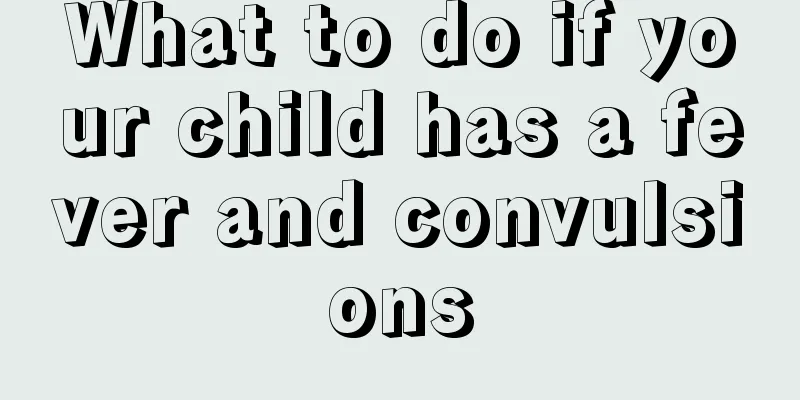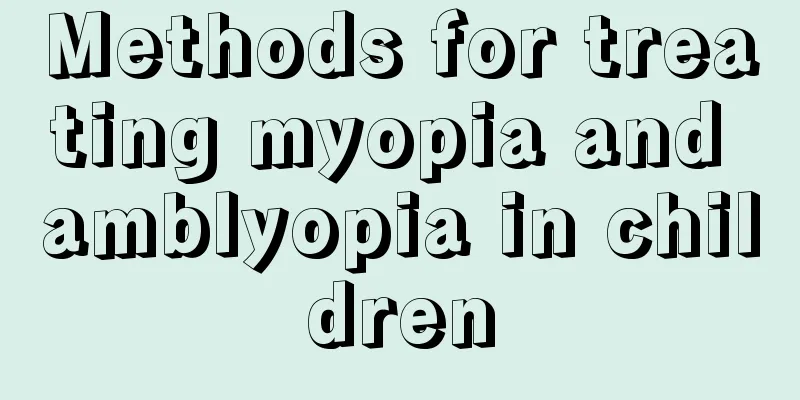What to do if your child has a fever and convulsions

|
We know that children are prone to convulsions when they have a fever, which is obviously very bad for their health. Parents are very curious about what to do when their children have a fever and convulsions. Knowing the solutions and following them can relieve the children's pain. Next, we will let pediatric experts introduce the specific solutions in detail. I hope that through my introduction, I can solve everyone’s confusion and doubts. A baby's fever and convulsions are medically called "febrile convulsions". This is mainly due to the imperfect development of the infant's nervous system, such as poor inhibitory function of the cerebral cortex and incomplete formation of the nerve myelin sheath. Once stimulated by external stimuli, the excitement can easily spread and cause convulsions. Generally speaking, infants and young children between 6 months and 4 years old, especially those who often catch colds and fevers, are more likely to suffer from febrile convulsions. Convulsions usually occur when the baby has a high fever, such as a body temperature of 39℃-40℃, and last for a relatively short time, about 2-3 minutes, and generally do not exceed 10 minutes. After the convulsion stopped, the child woke up. Methods/Steps 1. Adjust your posture When your baby has a seizure, lay him or her flat on his or her back, making sure he or she is not touching any sharp, hard objects. Later, lay your child on his side to allow him to breathe more easily and prevent saliva or vomit from blocking his trachea. Do not try to pry your child's mouth open; a child who is having a seizure due to a fever or other cause is not in danger of biting his tongue. 2. Ventilate frequently If there is air conditioning at home, maintain the room temperature between 25 and 27 degrees Celsius. You can place the child in an air-conditioned room or use an electric fan to blow around him to slowly lower the body temperature, so that the child will feel more comfortable. But if the limbs are cold and the patient is shivering violently, it means that the patient needs warmth, so he should be covered with a blanket. 3. Take off your clothes If your baby's limbs, hands and feet are warm and he is sweating all over, it means he needs to dissipate heat and he can wear less clothes. 4. Wipe with warm water Undress your baby and rub his whole body with a warm towel. This will dilate the blood vessels in the baby's skin and release body energy. In addition, when water vapor evaporates from the body surface, it will also absorb body heat. 5. Drink plenty of water To help sweating and prevent dehydration. Water has the function of regulating temperature, which can lower body temperature and replenish water lost in the baby's body. 6. Antipyretics When the baby's body temperature exceeds 38.5℃, you can use antipyretic medicine appropriately. What should you do if your child has a fever and convulsions? I believe that after reading the above article, everyone will have a certain understanding of this issue. When parents find that their children have symptoms of fever and convulsions, they can take the above measures. If everyone takes these measures, convulsions can be resolved sooner, and the child will feel much more comfortable, which is a good thing. |
<<: Causes of cold hands in children with fever
>>: What to do if a three-year-old child suddenly has a fever
Recommend
Causes of shortness of breath in babies with colds
The health of a baby is related to the happiness ...
Why do we spank children as soon as they cry?
It is normal for children to cry, everyone goes t...
How to quickly eliminate baby's bloating and diarrhea
The baby's stomach and intestines are usually...
How to treat chronic rhinitis in children?
Children's chronic rhinitis may be caused by ...
What are the symptoms of concussion in children?
When children are young, their bodies are not ful...
Can children drink Isatis root frequently?
Although Isatis root is a traditional Chinese med...
Reasons why babies have dark complexion
A baby's face turns dark, which is a kind of ...
Reasons and solutions for 16-month-old babies not liking to eat
I have a sixteen-month-old baby at home, but what...
What should I do if my child has a fever?
We all know that children's resistance is ver...
What to do if your newborn hiccups
For many new parents, the arrival of a baby often...
What to do if your child is restless when sleeping and easily startled
Before a child is six months old, many organs of ...
How to care for erythrasma in babies
Red ringworm on babies is a headache for many par...
The reason why two-year-old baby's teeth turn yellow
There must be a method to take care of the baby. ...
What are the symptoms and causes of intestinal obstruction in children?
Regarding intestinal obstruction in children, bas...
Nine-month-old baby recipes and steps
Today, the editor will lead you to understand the...









